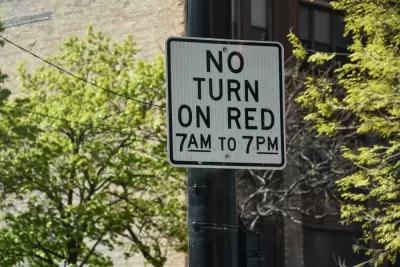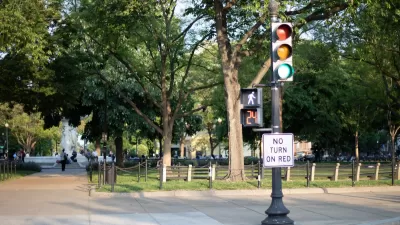Taking a second look at the widespread, but dangerous, practice.

Turning right on a red light may seem like an age-old tradition, but as Erika Bolstad explains in Stateline, the practice was primarily motivated by the oil embargo of the 1970s, when it was seen as a conservation measure. But as traffic fatalities continue to rise year after year, policymakers are taking a hard look at the practice and reconsidering its benefits and drawbacks.
Some states and cities are ending the practice: “Washington, D.C., will end most right-on-red turns by 2025. Already, the state of Hawaii has prohibited them on a tourist-dense stretch of road in Honolulu. The city of Berkeley in California is considering banning right on red at all intersections. Near the University of Michigan in Ann Arbor, the city last fall banned right turns at 50 signalized intersections in its downtown core.”
While rigorous studies about right turns on red remain scarce, “the studies that are emerging are beginning to show that limiting the practice can reduce crashes and close calls, and that drivers accommodate to the prohibition.” In one example, “A study by the District Department of Transportation in Washington, D.C., found that when the city banned right on red at 100 intersections in 2018, most drivers complied and there were fewer conflicts between pedestrians and vehicles.”
FULL STORY: States Consider Ending Right on Red to Address Rising Pedestrian Deaths

Planetizen Federal Action Tracker
A weekly monitor of how Trump’s orders and actions are impacting planners and planning in America.

Congressman Proposes Bill to Rename DC Metro “Trump Train”
The Make Autorail Great Again Act would withhold federal funding to the system until the Washington Metropolitan Area Transit Authority (WMATA), rebrands as the Washington Metropolitan Authority for Greater Access (WMAGA).

The Simple Legislative Tool Transforming Vacant Downtowns
In California, Michigan and Georgia, an easy win is bringing dollars — and delight — back to city centers.

The States Losing Rural Delivery Rooms at an Alarming Pace
In some states, as few as 9% of rural hospitals still deliver babies. As a result, rising pre-term births, no adequate pre-term care and "harrowing" close calls are a growing reality.

The Small South Asian Republic Going all in on EVs
Thanks to one simple policy change less than five years ago, 65% of new cars in this Himalayan country are now electric.

DC Backpedals on Bike Lane Protection, Swaps Barriers for Paint
Citing aesthetic concerns, the city is removing the concrete barriers and flexposts that once separated Arizona Avenue cyclists from motor vehicles.
Urban Design for Planners 1: Software Tools
This six-course series explores essential urban design concepts using open source software and equips planners with the tools they need to participate fully in the urban design process.
Planning for Universal Design
Learn the tools for implementing Universal Design in planning regulations.
Smith Gee Studio
City of Charlotte
City of Camden Redevelopment Agency
City of Astoria
Transportation Research & Education Center (TREC) at Portland State University
US High Speed Rail Association
City of Camden Redevelopment Agency
Municipality of Princeton (NJ)





























